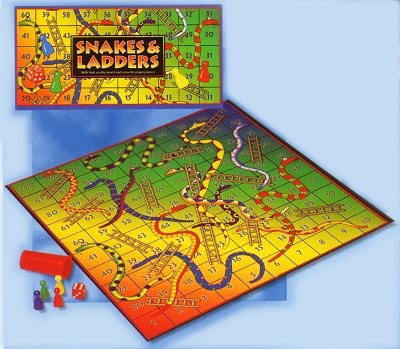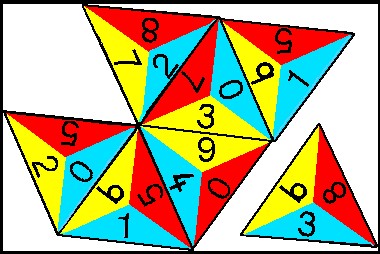Resource 2: Games to practise numeracy skills
![]() Teacher resource for planning or adapting to use with pupils
Teacher resource for planning or adapting to use with pupils
Ludo
A simple children’s board game for two to four players, in which the players race their four tokens from start to finish according to the way the dice falls.

Players take it in turns to throw the dice and move their tokens round the board. When a player throws a 6 they have the option to start to move another token around the board. If a player’s token lands on a space that is already occupied by another player’s token, that player has to remove their token from the board and wait until they have thrown a 6 to start again. The winner is the first player to get their four tokens to the centre of the board landing on their matching coloured area.

Snakes and ladders
Players take it in turns to throw the dice and move their tokens around the board. If they land on the bottom of a ‘ladder’ they go up to the square at the top of the ladder. If they land on a ‘snake’s’ head they travel down to the square at the tail of the snake.

The pictures of the games here are all of commercially made versions, but it is very easy to make your own simplified versions out of local materials. Why not work with a local senior school and see if their pupils can make some games as part of a technology project?
Bingo
Bingo is a game of chance where randomly selected numbers are written on a bingo card (example below). One person, ‘the caller’, writes the numbers 10–99 (or whatever digits you want to use with your class – it could be a mixture of single and double) usually on small balls, but you can use small cards, and then selects them without looking and calls the numbers out. Players who can match that number cover their cards with a counter, or cross the number off. The important thing for the caller is that they remember to keep the numbers that have already been called separate: they will need them later for checking. The caller keeps selecting and calling until one person has covered a line (horizontally, vertically or diagonally). If a player covers a whole line they have to shout out ‘BINGO!’ The caller needs to check the player’s card is correct and declares him or her the winner. Players can have more than one card in progress at a time.

A loop card game
‘Loop card’ games keep pupils ‘on their toes’ and listening, as all are involved and they do not know when their card will come up.
Intructions
Each card has a number such as 12 (or any other number) and a question. The question can simply be about adding or multiplying numbers, or could involve all four rules of number depending on what you want the pupils to practise. You can therefore make different sets of these cards, easy and hard, to use at different times. For example, some cards could help pupils who have particular problems with larger numbers. The examples in the picture below are about halving and doubling.
You need enough cards for each pupil to have one card. You could also make cards using money, distance etc. as a topic.
To play the game, the pupils could sit at their desks or you could organise them into a big circle. Give out a card to each pupil. Choose one pupil to start by reading out their question. The child who has the correct answer stands up and says the answer. If they are correct, they read their question. The child with the correct answer to this new question stands up and reads out their question and so it goes on until all the pupils are standing (or sitting if they all start standing up).
Do not have more than one card with the same number as this will confuse the pupils. You can use this game often as your pupils will get different cards each time. It is a good activity to use at the end of a lesson when all other work is finished, and is good practice for their mental mathematics skills.

The triangle number game
The triangle number game is the most versatile mathematics game for primary children. The game is played much like dominoes, where numbers are matched to each other to make a pattern. Two sides of the triangles are put together according to a chosen rule. In the example below, the ‘rule’ is that the two numbers must add up to 9.

For older pupils, the winner is the one to finish their cards first, but younger children usually play cooperatively. The game is best with 2–4 players, although it can be used by one as a ‘patience’.
Resource 1: Number bond games



